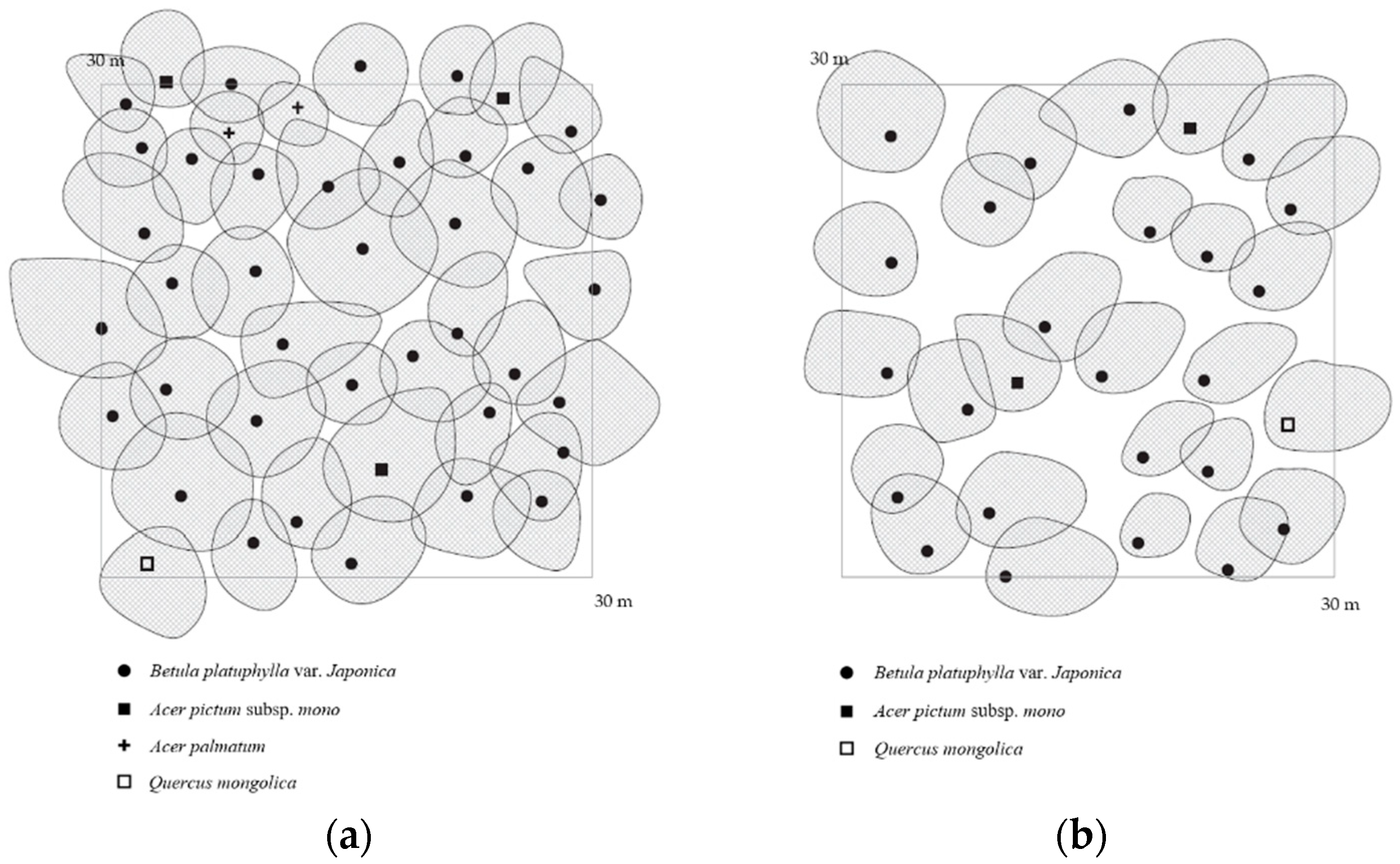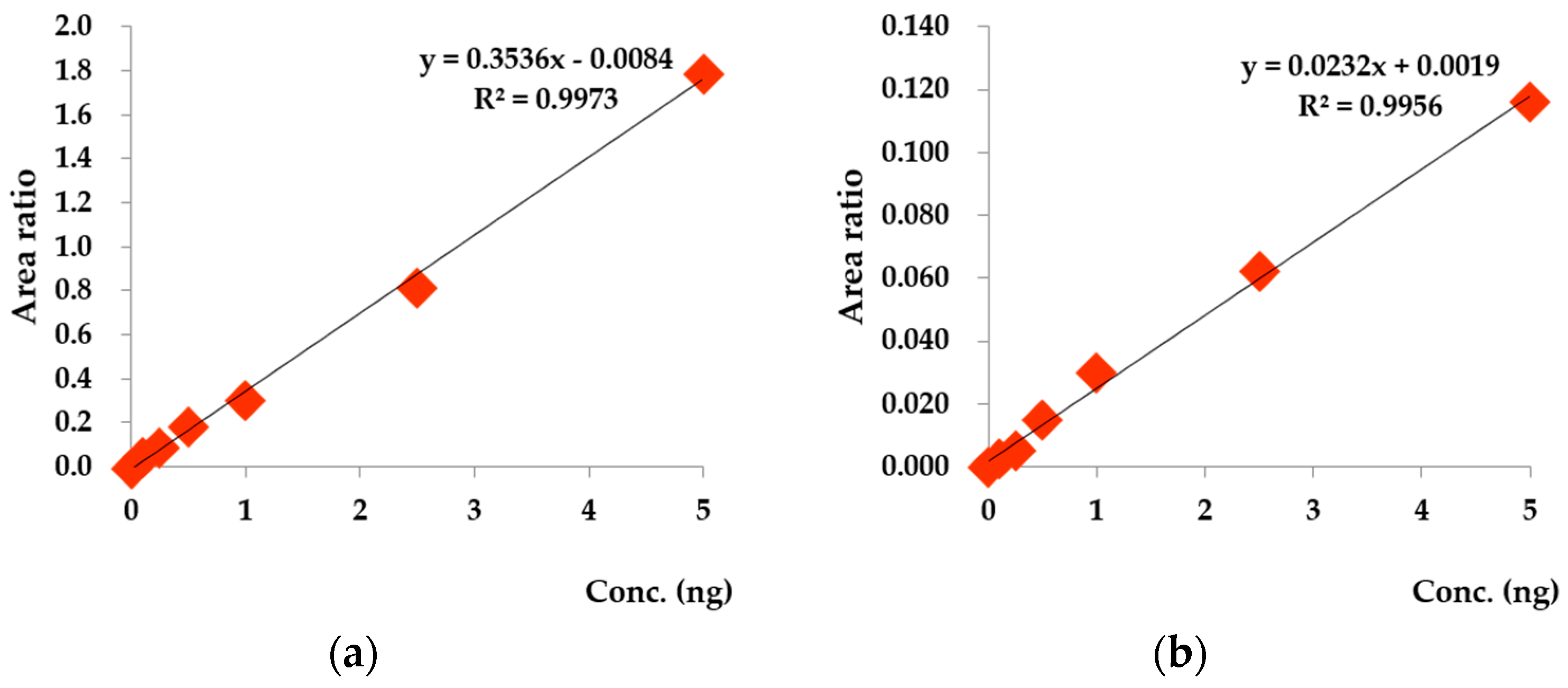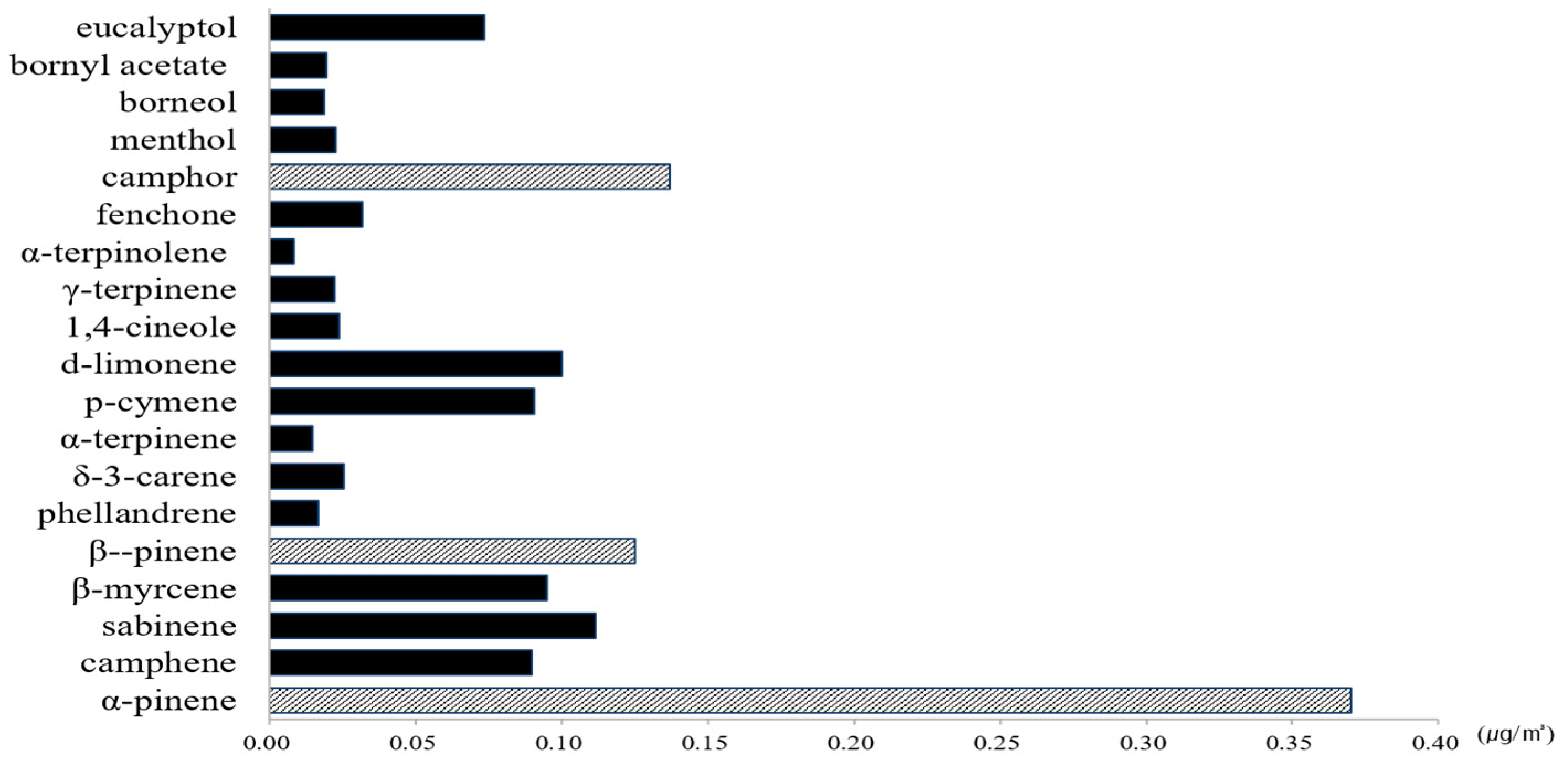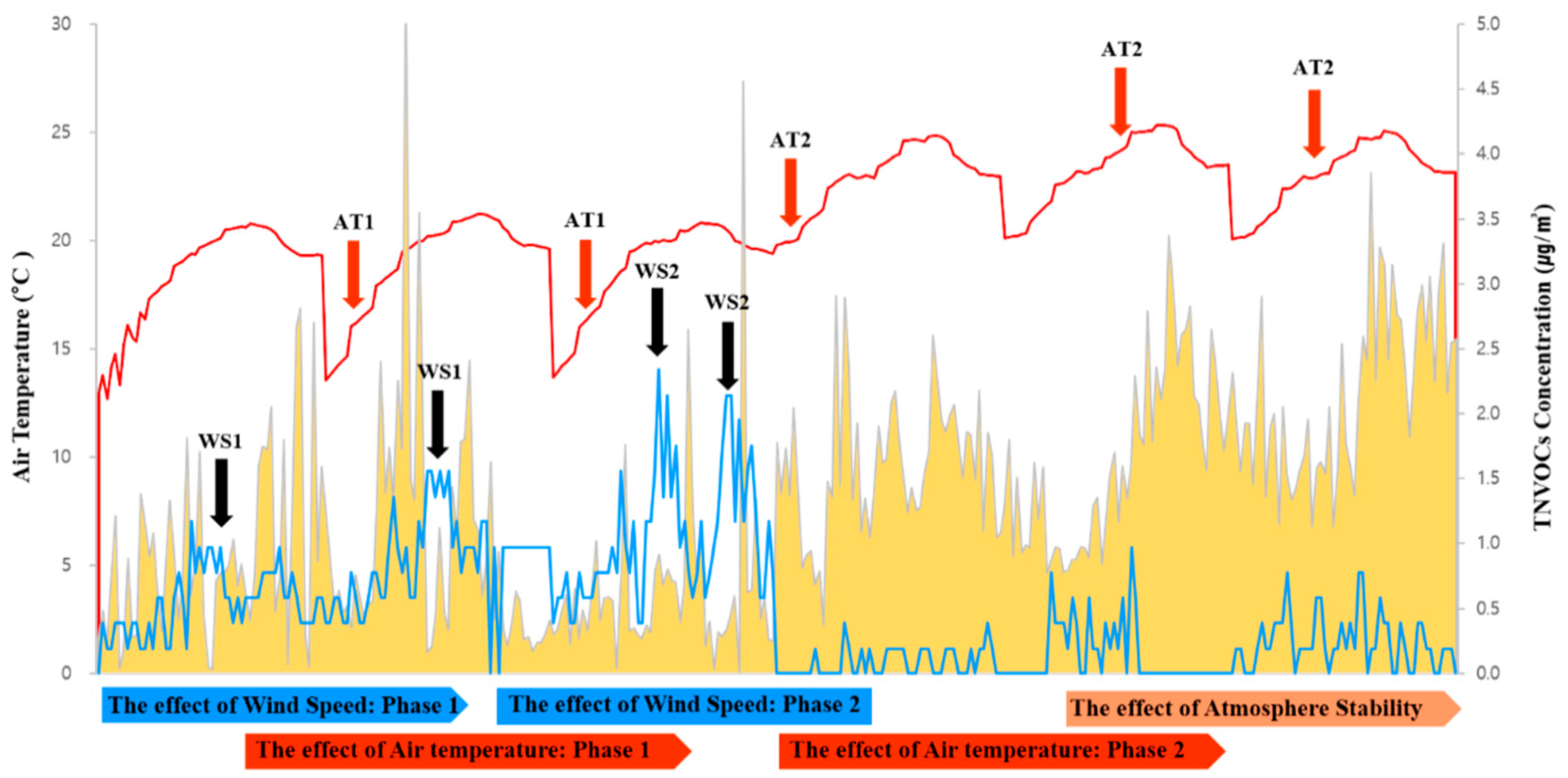Is It Possible to Predict the Concentration of Natural Volatile Organic Compounds in Forest Atmosphere?
Abstract
1. Introduction
2. Materials and Methods
2.1. Study Site
2.2. Measurement Factors
2.3. Measurement Methods
2.3.1. Natural Volatile Organic Compounds
2.3.2. Microclimate Environment
2.3.3. Data Analysis
3. Results
3.1. Characteristics of NVOCs at Betula platyphylla Forest
3.2. The Intraday Variation of NVOC Concentration at the Betula platyphylla Forest
3.3. Relationship between NVOC and Microclimate at the Betula platyphylla Forest
3.4. Prediction Model for NVOC Concentration in Betula Platyphylla Forest
4. Discussion
5. Conclusions
Author Contributions
Funding
Conflicts of Interest
References
- Marin, M.F.; Lord, C.; Andrew, J.; Juster, R.P.; Sindi, S.; Arsenault-Lapierre, G.; Fiocco, A.J.; Lupien, S.J. Chronic stress, cognitive functioning and mental health. Neurobiol. Learn. Mem. 2011, 96, 583–595. [Google Scholar] [CrossRef]
- Tafet, G.E.; Bernardini, R. Psychoneuroenendocrinological links between chronic stress and depression. Prog. Neuropsychopharmacol. Biol. Psychiatry 2003, 27, 893–903. [Google Scholar] [CrossRef]
- Korea Centers for Disease Control & Prevention. Korea National Health and Nutrition Examination Survey; Korea Centers for Disease Control & Prevention: Cheongju, Chungcheongbuk-do, Korea, 2019; pp. 1–50.
- World Health Organization. World Health Organization Global Coordination Mechanism on Noncommunicable Diseases; WHO Press: Geneva, Switzerland, 2015; pp. 1–56. [Google Scholar]
- Hatig, T.; Mang, M.; Evans, G.W. Restorative effects of natural environment experience. Environ. Behav. 1991, 23, 3–27. [Google Scholar] [CrossRef]
- Maas, J.; van Dillen, S.M.E.; Verheij, R.A.; Groenewegen, P.P. Social contacts as a possible mechanism behind the relation between green space and health. Health Place 2009, 15, 586–595. [Google Scholar] [CrossRef] [PubMed]
- Li, Q. What is forest medicine? In Forest Medicine; Li, Q., Ed.; Nova Science Publishers: New York, NY, USA, 2012; pp. 1–8. [Google Scholar]
- Shin, W.S.; Kim, J.J.; Lim, S.S.; Yoo, R.H.; Jeong, M.A.; Lee, J.; Park, S. Paradigm shift on forest utilization: Forest service for health promotion in the Republic of Korea. Net. J. Agric. Sci. 2017, 5, 53–57. [Google Scholar] [CrossRef][Green Version]
- Jeong, D.; Kim, G.; Choi, Y.; Lim, H.; Park, S.; Woo, J.M.; Park, B.J. The prefrontal cortex activity and psychological effects of viewing forest landscapes in autumn season. Int. J. Environ. Res. Public Health 2015, 12, 7235–7243. [Google Scholar] [CrossRef] [PubMed]
- Song, C.; Ikei, H.; Park, B.J.; Lee, J.; Kagawa, T.; Miyazaki, Y. Psychological benefits of walking through forest area. Int. J. Environ. Res. Public Health 2018, 15, 2804. [Google Scholar] [CrossRef]
- Li, Q.; Morimoto, K.; Kobayashi, M.; Inagaki, H.; Katsumata, M.; Hirata, Y.; Hirata, K.; Suzuki, H.; Li, Y.J.; Wakayama, Y. Visiting a forest, but not a city, increases human natural killer activity and expression of anti-cancer proteins. Int. J. Immunopathol. Pharmacol. 2008, 21, 117–127. [Google Scholar] [CrossRef]
- Li, Q.; Kobayashi, M.; Wakayama, Y.; Inagaki, H.; Katsumata, M.; Hirata, Y.; Hirata, K.; Shimizu, T.; Kawada, T.; Park, B.J.; et al. Effect of phytoncide from trees on human natural killer cell function. Int. J. Immunopathol. Pharmacol. 2009, 4, 951–959. [Google Scholar] [CrossRef]
- Ochiai, H.; Ikei, H.; Song, C.; Kobayashi, M.; Takamatsu, A.; Miura, T.; Kagawa, T.; Li, Q.; Kumeda, S.; Imai, M.; et al. Physiological and psychological effects of forest therapy on middle-aged males with high-nomal blood pressure. Int. J. Environ. Res. Public Health 2015, 12, 2532–2542. [Google Scholar]
- Park, B.J.; Tsunetsugu, Y.; Kasetani, T.; Hirano, H.; Kagawa, T.; Sato, M.; Miyazaki, Y. Physiological effects of Shinrin-yoku (taking in the atmosphere of the forest)-using salivary cortisol and cerebral activity as indicators. J. Physiol. Anthropol. 2007, 26, 123–128. [Google Scholar] [CrossRef]
- Bang, K.S.; Kim, S.; Song, M.K.; Kang, K.I.; Jeong, Y. The effects of a health promotion program using urban forests and nursing student mentors on the perceived and psychological health of elementary school children in vulnerable populations. Int. J. Environ. Res. Public Health 2018, 15, 1977. [Google Scholar] [CrossRef]
- Lee, H.J.; Son, Y.H.; Kim, S.; Lee, D.G. Healing experiences of middle-aged women through an urban forest therapy program. Urban For. Urban Green. 2019, 38, 383–391. [Google Scholar] [CrossRef]
- Joung, D.W.; Lee, B.H.; Lee, J.D.; Lee, C.J.; Koo, S.M.; Park, C.W.; Kim, S.B.; Kagawa, T.; Park, B.J. Measures to promote rural healthcare tourism with a scientific evidence-based approach. Int. J. Environ. Res. Public Health 2020, 17, 3266. [Google Scholar] [CrossRef] [PubMed]
- Albert, B.P.; Josep, P.; Jana, C.; Joan, L.; Ferran, C.L.; Roser, M. How should forests be characterized in regard to human health? Evidence from existing literature. Int. J. Environ. Res. Public Health 2020, 17, 1027. [Google Scholar]
- Ilaria, D.; Mauro, M.; Paola, G. Forest wellbeing: Bridging medical and forest research for effective forest-based initiatives. Forests 2020, 11, 791. [Google Scholar]
- Kim, E.C.; Lee, H.S.; Kim, S.K.; Choi, M.S.; Lee, E.S.; Han, J.B.; An, H.J.; Um, J.Y.; Kim, H.M.; Lee, N.Y.; et al. The bark of Betula platyphylla var. japonica inhibits the development of atopic dermatitis-like skin lesions in NC/Nga mice. J. Ethnopharmacol. 2008, 116, 270–278. [Google Scholar] [CrossRef] [PubMed]
- Eom, H.J.; Kang, H.R.; Kim, H.K.; Jung, E.B.; Park, H.B.; Kang, K.S.; Kim, K.H. Bioactivity-guided isolation of antioxidant triterpenoids from Betula platyphylla var. japonica bark. Bioorg. Chem. 2016, 66, 97–101. [Google Scholar] [CrossRef] [PubMed]
- So, H.M.; Eom, H.J.; Lee, D.H.; Kim, S.; Kang, K.S.; Lee, I.K.; Baek, K.H.; Park, J.Y.; Kim, K.H. Bioactivity evaluations of betulin identified from the bark of Betula platyphylla var. japonica for cancer therapy. Arch. Pharmacal. Res. 2018, 41, 815–822. [Google Scholar] [CrossRef] [PubMed]
- Kesselmeier, J.; Staudt, M. Biogenic volatile organic compounds (VOC): An overview on emission, physiology and ecology. J. Atmos. Chem. 1999, 33, 23–88. [Google Scholar] [CrossRef]
- Yatagi, M.; Ohira, M.; Ohira, T.; Nagai, S. Seasonal variations of terpene emission from trees and influence of temperature, light, and contact stimulation on terpene emission. Chemosphere 1995, 30, 1137–1149. [Google Scholar] [CrossRef]
- Trapp, D.; Cooke, K.M.; Fischer, H.; Bonsang, B.; Zitzelsberger, R.U.; Seuwen, R.; Schiller, C.; Zenker, T.; Parchatka, U.; Nunes, T.V.; et al. Isoprene and its degradation products methyl vinyl ketone, methacrolein, and formaldehyde in a eucalyptus. Chemosphere 2001, 3, 295–307. [Google Scholar]
- Tani, A.; Nozoe, S.; Aoki, M.; Hewitt, C.N. Monoterpene fluxes measured above a Japanese red pine forest at Oshiba plateau, Japan. Atmos. Environ. 2002, 36, 3391–3402. [Google Scholar] [CrossRef]
- Wang, S.Y.; Lai, W.C.; Chu, F.H.; Lin, C.T.; Shen, S.Y.; Chang, S.T. Essential oil from the leaves of Cryptomeria japonica acts as a silverfish (Lepisma saccharina) repellent and insecticide. J. Wood Sci. 2006, 52, 522–526. [Google Scholar] [CrossRef]
- Tani, A.; Kawawata, J. Isoprene emission from the major native Quercus spp. in Japan. Atmos. Environ. 2008, 42, 4540–4550. [Google Scholar] [CrossRef]
- Yang, Z.; Wu, N.; Zu, Y.; Fu, Y. Comparative anti-infectious bronchitis virus (IBV) activity of (-)-pinene: Effect on nucleocapsid (N) protein. Molecules 2011, 16, 1044–1054. [Google Scholar] [CrossRef]
- Wang, W.; Li, N.; Luo, M.; Zu, Y.; Efferth, T. Antibacterial activity and anticancer activity of Rosmarinus officinalis L. essential oil compared to that of its main components. Molecules 2012, 17, 2704–2713. [Google Scholar] [CrossRef]
- Juven, B.J.; Kanner, J.; Schved, F.; Weisslowicz, H. Factors that interact with the antibacterial action of thyme essential oil and its active constituents. J. Bacteriol. 1994, 76, 626–631. [Google Scholar] [CrossRef]
- Gustafson, J.E.; Liew, Y.C.; Chew, S.; Markham, J.; Bell, H.C.; Wyllie, S.G.; Warmington, J.R. Effects of tea tree oil on Escherichia coli. Appl. Microbiol. 1998, 26, 194–198. [Google Scholar] [CrossRef]
- Cox, S.D.; Mann, C.M.; Markham, J.L.; Bell, H.C.; Gustafson, J.E.; Warmington, J.R.; Wyllie, S.G. The mode of antimicrobial action of the essential oil of Melaleuca alternifolia (tea tree oil). J. Appl. Microbiol. 2000, 88, 170–175. [Google Scholar] [CrossRef]
- Lambert, R.J.W.; Skandamis, P.N.; Coote, P.J.; Nychas, G.J. A study of the minimum inhibitory concentration and mode of action of oregano essential oil, thymol and carvacrol. J. Appl. Microbiol. 2001, 91, 453–462. [Google Scholar] [CrossRef] [PubMed]
- Eh, E.K.; Al-Ajmi, M.F.; Al-Bekairi, A.M. Some cardiovascular effects of the dethymoquinonated nigella sativa volatile oil and its major components α-pinene and p-cymene in rats. Saudi Pharm. J. 2003, 11, 104–110. [Google Scholar]
- McKay, S.A.B.; Hunter, W.L.; Godard, K.A.; Wang, S.X.; Martin, D.M. Insect attack and wounding induce traumatic resin duct development and gene expression of (-)-pinene synthase in Sitka spruce. Plant. Physiol. 2003, 133, 368–378. [Google Scholar] [CrossRef] [PubMed]
- Kawakami, K.; Kawamoto, M.; Nomura, M.; Otani, H.; Nibika, T.; Gonda, T. Effects of phytoncides on blood pressure under restraint stress in SHRSP. Clin. Exp. Pharmacol. Physiol. 2004, 31, S27–S28. [Google Scholar] [CrossRef] [PubMed]
- Yamaoka, S.; Tomita, T.; Imaizumi, Y.; Watanabe, K.; Hatanaka, A. Effects of plant-derived odors on sleep–wakefulness and circadian rhythmicity in rats. Chem. Senses 2005, 30, i264–i265. [Google Scholar] [CrossRef] [PubMed]
- Mercier, B.; Prost, J.; Prost, M. The essential oil of turpentine and its major volatile fraction (α-and β-pinenes): A review. Int. J. Occup. Med. Environ. Health 2009, 22, 331–342. [Google Scholar] [CrossRef]
- Lima, F.J.; Brito, T.S.; Freire, W.B.; Costa, R.C.; Linhares, M.I.; Sousa, F.C.; Lahlou, S.; Cardoso, J.H.L.; Santos, A.A.; Magalhães, P.J. The essential oil of Eucalyptus tereticornis, and its constituents α-and β-pinene, potentiate acetylcholine-induced contractions in isolated rat trachea. Fitoterapia 2010, 81, 649–655. [Google Scholar] [CrossRef]
- Menezes, I.A.; Bareeto, C.; Antoniolli, Â.R.; Santos, M.R.; Sousa, D.P.D. Hypotensive activity of terpenes found in essential oils. Z. Naturforsch. C Biosci. 2010, 65, 562–566. [Google Scholar] [CrossRef]
- Matsuo, A.L.; Figueiredo, C.R.; Arruda, D.C.; Pereira, F.V.; Scutti, J.A.B.; Massaoka, M.H.; Travassos, L.R.; Sartorelli, P.; Lago, J.H. α-Pinene isolated from Schinus terebinthifolius Raddi (Anacardiaceae) induces apoptosis and confers antimetastatic protection in a melanoma model. Biochem. Biophys. Res. Commun. 2011, 411, 449–454. [Google Scholar] [CrossRef]
- Lee, H.F.; Lee, T.S.; Kou, Y.R. Anti-inflammatory and neuroprotective effects of triptolide on traumatic brain injury in rats. Respir. Physiol. Neurobiol. 2012, 182, 1–8. [Google Scholar] [CrossRef]
- Mishra, A.K.; Mishra, A.; Verma, A.; Chattopadhyay, P. Effects of calendula essential oil-based cream on biochemical parameters of skin of albino rats against ultraviolet B radiation. Sci. Pharm. 2012, 80, 669–684. [Google Scholar] [CrossRef]
- Niinemets, Ü.; Loreto, F.; Reichstein, M. Physiological and physicochemical controls on foliar volatile organic compound emissions. Trends Plant Sci. 2004, 9, 180–186. [Google Scholar] [CrossRef]
- Monson, R.K.; Harley, P.C.; Litvak, M.E.; Wildermuth, M.; Guenther, A.B.; Zimmerman, P.R.; Fall, R. Environmental and developmental controls over the seasonal pattern of isoprene emission from aspen leaves. Oecologia 1994, 99, 260–270. [Google Scholar] [CrossRef]
- Baghi, R.; Helmig, D.; Guenther, A.; Duhl, T.; Daly, R. Contribution of flowering trees to urban atmospheric biogenic volatile organic compound emissions. Biogeosciences 2012, 9, 3777. [Google Scholar] [CrossRef]
- Peñuelas, J.; Joan, L. BVOCs: Plant defense against climate warming? Trends Plant Sci. 2003, 8, 105–109. [Google Scholar] [CrossRef]
- Geron, C.D.; Arnts, R.R. Seasonal monoterpene and sesquiterpene emissions from Pinus taeda and Pinus virginiana. Atmos. Environ. 2010, 44, 4240–4251. [Google Scholar] [CrossRef]
- Harley, P.; Eller, A.; Guenther, A.; Monson, R.K. Observations and models of emissions of volatile terpenoid compounds from needles of ponderosa pine trees growing in situ: Control by light, temperature and stomatal conductance. Oecologia 2014, 176, 35–55. [Google Scholar] [CrossRef] [PubMed]
- Juuti, S.; Arey, J.; Atkinson, R. Monoterpene emission rate measurements from a Monterey pine. J. Geophys. Res. Atmos. 1990, 95, 7515–7519. [Google Scholar] [CrossRef]
- Hakola, H.; Rinne, J.; Laurila, T. The hydrocarbon emission rates of tea-leafed willow (Salix phylicifolia), silver birch (Betula pendula) and European aspen (Populus tremula). Atmos. Environ. 1998, 32, 1825–1833. [Google Scholar] [CrossRef]
- Alves, E.G.; Jardine, K.; Tota, J.; Jardine, A.; Yãnez-Serrano, A.M.; Karl, T.; Tavares, J.; Nelson, B.; Gu, D.; Stavrakou, T.; et al. Seasonality of isoprenoid emissions from a primary rainforest in central Amazonia. Atmos. Chem. Phys. 2016, 16, 3903–3925. [Google Scholar] [CrossRef]
- Matsunaga, S.N.; Niwa, S.; Mochizuki, T.; Tani, A.; Kusumoto, D.; Utsumi, Y.; Enoki, T.; Hiura, T. Seasonal variation in basal emission rates and composition of mono-and sesquiterpenes emitted from dominant conifers in Japan. Atmos. Environ. 2013, 69, 124–130. [Google Scholar] [CrossRef]
- Bai, J.; Guenther, A.; Turnipseed, A.; Duhl, T.; Yu, S.; Wang, B. Seasonal and interannual variations in whole-ecosystems BVOC emissions from a subtropical bamboo plantation in China. Atmos. Environ. 2016, 124, 12–21. [Google Scholar] [CrossRef]
- Bai, J.; Guenther, A.; Turnipseed, A.; Duhl, T.; Greenberg, J. Seasonal and interannual variations in whole-ecosystems BVOC emissions from a subtropical plantation in China. Atmos. Environ. 2017, 161, 176–190. [Google Scholar] [CrossRef]
- Harrison, D.; Hunter, M.C.; Lewis, A.C.; Seakins, P.W.; Bonsang, B.; Gros, V.; Kanakidou, M.; Touaty, M.; Kavouras, I.; Mihalopoulos, N.; et al. Ambient isoprene and monoterpene concentrations in Greek fir (Abies borisii-regis) forest. Reconciliation with emissions measurements and effects on measured OH concentrations. Atmos. Environ. 2001, 27, 4699–4711. [Google Scholar] [CrossRef]
- Cerqueira, M.A.; Pio, C.A.; Gomes, P.A.; Matos, J.S.; Nunes, T.V. Volatile organic compounds in rural atmospheres of central Portugal. Sci. Environ. 2003, 313, 49–60. [Google Scholar] [CrossRef]
- Ren, Y.; Ge, Y.; Gu, B.; Min, Y.; Tani, A.; Chang, J. Role of management strategies and environmental factor in determing the emissions of biogenic volatile organic compounds from urban greenspaces. Environ. Sci. Technol. 2014, 48, 6237–6246. [Google Scholar] [CrossRef] [PubMed]
- Kim, G.; Park, B.J.; Joung, D.; Yeom, D.G.; Koga, S. Healing environments of major tree species in Kyushu university forests: A case study. J. Fac. Agric. Kyushu Univ. 2015, 60, 477–483. [Google Scholar]
- Kim, G.; Park, B.J.; Yeon, P.; Lee, S.; Joung, D.; Park, C.; Koga, S. Case study on the changes in the physical environment in forest healing spaces. J. Fac. Agric. Kyushu Univ. 2016, 61, 375–381. [Google Scholar]





| Parameters | Conditions | ||||
|---|---|---|---|---|---|
| Column | HP-INNOWAX (60 m × 0.25 mmL Dx 0.25 μm, film thickness) | ||||
| Carrier gas flow | He at 1 mL/min | ||||
| Injection mode | Pulsed Splitless | ||||
| Injection port temp. | 210 °C | ||||
| Transfer line temp. | 210 °C | ||||
| Oven temp. program | initial | Rate | final | ||
| 40 °C | 3 min | 8 °C/min | 220 °C | 3 min | |
| Post run | 220 °C, 5 min | ||||
| Variables | TNVOC | Temp. 1 | Hum. 2 | Vel. 3 | |
|---|---|---|---|---|---|
| TNVOC | correlation | 1 | 0.649 ** | 0.681 ** | −0.567 ** |
| Sig. | 0.000 | 0.000 | 0.000 | ||
| N | 282 | 282 | 282 | 282 | |
| Variables | SE | Beta | t | VIF | R2 | F | D-W |
|---|---|---|---|---|---|---|---|
| Constant | 0.219 | −5.501 | 0.601 | 83.296 (0.000) | 1.990 | ||
| Temp. 1 | 0.011 | 0.412 | 8.914 | 1.479 | |||
| Hum. 2 | 0.002 | 0.296 | 4.492 | 3.016 | |||
| Vel. 3 | 0.082 | −0.190 | −3.164 | 2.492 |
Publisher’s Note: MDPI stays neutral with regard to jurisdictional claims in published maps and institutional affiliations. |
© 2020 by the authors. Licensee MDPI, Basel, Switzerland. This article is an open access article distributed under the terms and conditions of the Creative Commons Attribution (CC BY) license (http://creativecommons.org/licenses/by/4.0/).
Share and Cite
Kim, G.; Park, S.; Kwak, D. Is It Possible to Predict the Concentration of Natural Volatile Organic Compounds in Forest Atmosphere? Int. J. Environ. Res. Public Health 2020, 17, 7875. https://doi.org/10.3390/ijerph17217875
Kim G, Park S, Kwak D. Is It Possible to Predict the Concentration of Natural Volatile Organic Compounds in Forest Atmosphere? International Journal of Environmental Research and Public Health. 2020; 17(21):7875. https://doi.org/10.3390/ijerph17217875
Chicago/Turabian StyleKim, Geonwoo, Sujin Park, and Dooahn Kwak. 2020. "Is It Possible to Predict the Concentration of Natural Volatile Organic Compounds in Forest Atmosphere?" International Journal of Environmental Research and Public Health 17, no. 21: 7875. https://doi.org/10.3390/ijerph17217875
APA StyleKim, G., Park, S., & Kwak, D. (2020). Is It Possible to Predict the Concentration of Natural Volatile Organic Compounds in Forest Atmosphere? International Journal of Environmental Research and Public Health, 17(21), 7875. https://doi.org/10.3390/ijerph17217875







